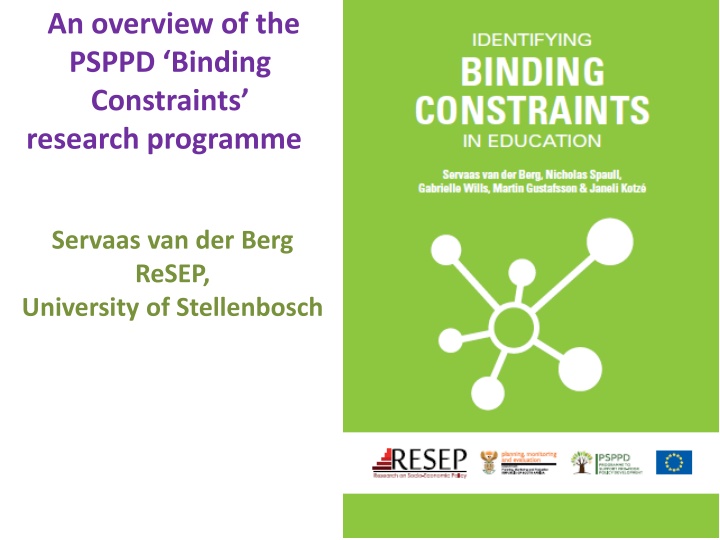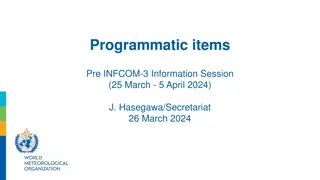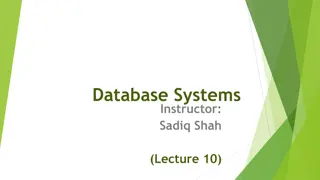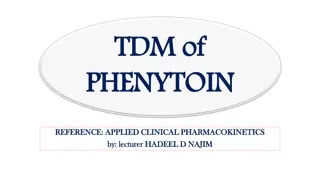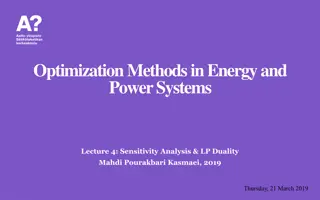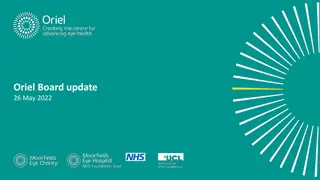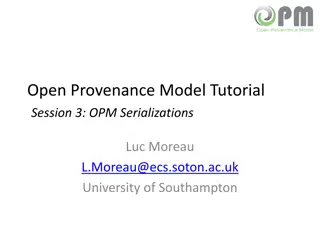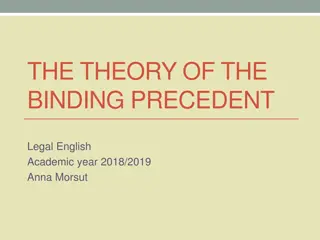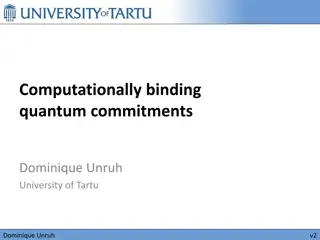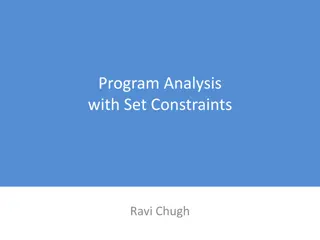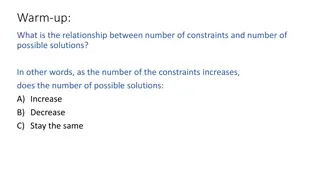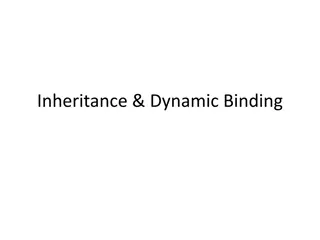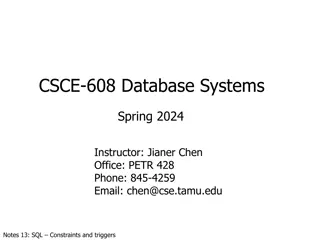Insights into PSPPD Binding Constraints Research Programme
Research by Servaas van der Berg and colleagues explores binding constraints affecting educational outcomes, emphasizing weak institutional functionality, undue union influence, teacher knowledge gaps, and wasted learning time. The study also highlights low educational accountability and capacity as root causes. Data analysis from PIRLS 2006 and V-ANA responses in 2011 reveal critical performance gaps in education between England and South Africa.
Download Presentation

Please find below an Image/Link to download the presentation.
The content on the website is provided AS IS for your information and personal use only. It may not be sold, licensed, or shared on other websites without obtaining consent from the author.If you encounter any issues during the download, it is possible that the publisher has removed the file from their server.
You are allowed to download the files provided on this website for personal or commercial use, subject to the condition that they are used lawfully. All files are the property of their respective owners.
The content on the website is provided AS IS for your information and personal use only. It may not be sold, licensed, or shared on other websites without obtaining consent from the author.
E N D
Presentation Transcript
An overview of the PSPPD Binding Constraints research programme Servaas van der Berg ReSEP, University of Stellenbosch
Researchers Paula Armstrong Annika Bergbauer Carol Nuga Deliwe* Jaamia Galant Janet Graaff Martin Gustafsson Ursula Hoadley Dumisani Hompashe Janeli Kotz Nompumelelo Mohohlwane* Megan Sager * - DBE personnel Debra Shepherd Nicholas Spaull Stephen Taylor* Hendrik van Broekhuizen Servaas van der Berg Surette van Staden Chris van Wyk Ntsizwa Vilakazi* Marisa von Fintel Gabrielle Wills
Introduction Research for these two reports (for PSPPD & Zenex) has (already) also generated: 10 journal articles 12 policy briefs 11 working papers 1 concept note outlining structure and content of a course to teach FP teachers how to teach reading 2 policy engagement workshops Research was given added stimulus by conference and by Learning Exchange This report provides an overview of this research through two conceptual lenses: Prioritisation, focus on binding constraints Acknowledgment that root causes of low educational outcomes are (1) a lack of accountability, and/or (2) a lack of capacity From existing literature and new research, four binding constraints emerge: (1) Weak institutional functionality (2) Undue union influence (3) Weak teacher content knowledge and pedagogical skills (4) Wasted learning time and insufficient opportunity to learn These lead to weak educational outcomes
Cumulative performance in in England and SA 100 90 80 Cumulative % of students SA Gr5s 70 60 50 40 England Gr4s 30 20 Source: Derived from PIRLS 2006 10 0 0 200 400 600 800 Score in PIRLS 2006
Some V-ANA responses in 2011 In 2011 V-ANA, only 16% of Gr3s could answer this question: 72 37 = Almost half (46%) could not identify the tallest member of this team The height of netball players in one team 180 160 Height of players in cm 140 120 100 80 60 40 20 0 Amy Pat Neo Lu Kim Sue Ash Names of players Only 9% of Gr6s could answer 10% of 180 is equal to
Data from NSES Only 24% of South African Gr5 children can answer this Gr2 level question Pam has R40. She spends R28. How much money does she have left? Is language perhaps the barrier? Then how can one explain that only 14% of Gr5s could answer this Gr3-level question? 105 7 Source: Janeli Kotz , 2013
The centrality of learning to read 60% of SA children do not learn to read for meaning in any language by the end of Gr3 That, by itself, then becomes another constraint to further learning Students who have failed to learn to read cannot subsequently read to learn For all subjects, the curriculum assumes that children have learned how to read by the end of Gr3 But most SA children do not acquire the most basic reading skills, thus never fully accessing the curriculum despite being promoted to higher grades Thus we recommend that DBE s foundational goal should be: Every child must learn to read for meaning by the end of Grade 3. This goal is measurable, understandable, pedagogically sound
% of Gr4 students that are (1) illiterate and (2) cannot read for meaning in the FP LOLT of the school Source: Based on prePIRLS 2011 90% 83% 80% 66% 70% 63% 60% 58% 57% 60% 50% 50% 44% 40% 32% 32% 29% 29% 27% 30% 26% 21% 20% 11% 10% 0% % Illiterate % Cannot read for meaning
Oral reading fluency scores for rural SA African English Language Students (ESL) relative to Broward County ESL Students (Florida, US) Source: Draper & Spaull 2015, using NEEDU data
Neglect of Foundation Phase: FP and FET phase teachers visited by a subject/curriculum advisor during 2011 Source: Wills 2015, using SMS data
The Binding Constraints Approach Not all constraints bind equally, thus need to prioritise ... senior public officials should focus most of their attention on a few strategic priorities (NDP) Certain things must be tackled first, as they preclude progress in other areas Impossible for government to focus on many interventions at once better to do a few well
Binding Constraint #1: Weak Institutional Functionality Given education decentralisation, implementation depends on provincial functionality Difficult to quantify importance of state functionality Due to border changes in 2005, some schools changed provinces. Gustafsson & Taylor (2016) used this to measure improvements in matric results over five years for schools transferred from Northwest to Gauteng This shows the clear importance of improving administration of under-performing provinces
Binding Constraint #2: Undue union influence Concern that influence of trade unions, specifically SADTU, interferes with the system s ability to act in the best interests of children This undermines efforts to implement more accountability and compromises capabilities Mechanisms of undue union influence: (1) Compromised post-provisioning, thus overspending on teacher salaries (2) Compromised design and implementation of accountability systems (3) Compromised independence and accountability function of SACE (4) Compromised bureaucratic accountability (5) Compromised levels of citizen trust in the public education sector Especially important in appointments and promotions Nepotistic or corrupt appointments linked serious and systemic; Volmink Commission makes some important recommendations Addressing this is even more urgent given that large number of principals will retire in the next five years (Wills (2015))
Binding Constraint #3: Weak teacher content knowledge & pedagogical skills Many teachers lack basic content knowledge and pedagogical skills SACMEQ 2007 showed that only 32% of Gr6 maths teachers in SA had desirable subject knowledge, compared with Kenya (90%), Zimbabwe (76%), Swaziland (55%) In Mpumalanga only 4%, in WCape 64% 79% of Gr6 maths teachers have content knowledge level below Gr6/7 level, especially in poorest four quintiles Hoadley s (2016) literature review, in combination with existing research, confirms that weak teacher knowledge creates a low ceiling
% of Gr6 students with teachers with desirable levels of maths subject knowledge (SACMEQ, 2007) 100 90 90 Source: Own analysis using Hungi et al. (2011) 76 80 66 65 70 64 55 60 46 50 41 36 35 40 32 28 30 24 19 20 6 10 0
Binding Constraint #4: Wasted learning time and insufficient opportunity to learn (OTL) Low OTL could result from either lack of capacity (teachers lack the knowledge to teach some content areas) or of accountability (no monitoring by principal, district officials) SA studies show less than half of curriculum is covered, fewer than half lessons taught NSES study showed most Gr5s write in their books at most once per week; only 3% did so every day In Gr4 and Gr5 exercise books, about half of all exercises were single word exercises Of greatest concern is how little extended writing there is in the books , learners write one paragraph every month and a half of school. (Dechaisemartin, 2013) 44% of Gr4 students had not written any paragraphs during the entire school year 2011 School Monitoring Survey shows only 53% of Gr6 & Gr9 students had covered the minimum exercises needed for curriculum coverage: Gauteng 85%, WCape 76%, ECape27%, 24% North West Hoadley & Galant (2016) explored workbook use as a practice, assessment or monitoring tool: The overall high level of curriculum compliance of the workbooks suggests they could be effective as a monitoring tool at a systemic level. It would be possible to gain a crude measure of coverage in key content areas. They also comment on the potential complementarity of textbook and workbook: (the) textbook could usefully be aligned with the workbooks. The textbook could then function as a primary transmission text, with clear conceptual signalling as well as relevant tasks, and the workbook could function as a practice tool, either for use in class or as a homework resource.
Roadmap for Reading Policy recommendations related to reading specifically (Ch10) and five other areas of policy concern (Ch11) Chapter 10, Roadmap for Reading , outlines four stages for successful implementation of a national reading strategy: (1) Prioritisation (2) Preparation (3) Implementation (4) Sustainability Across each stage six core components must be aligned: (1) Beginning (2) Collaboration (3) Capacity (4) Accountability (5) Alignment (6) Budget This involves detailed and concrete steps, as set out in Roadmap for Reading
Priority? Early? Grade? Reading? Goal? for? the? DBE: "All? ? learners? read? fluently? and? with? comprehension? by? the? end? of? grade? 3."? 2.? ? PREPARE? 1.? PRIORITISE? 3.? IMPLEMENT? 4.? ? SUSTAIN? (A)? ? ? ? ? ? ? ? ? ? ? ? Effectively? brand? and? communicate? the? national? early? grade? reading? strategy? and? reading? goals? across? all? education? tiers.? Bi-annual? feedback? to? all? education? tiers? about? school? and? district? performance? against? measurable? reading? goals. Beginning IN-SET? on? 'how? to? teach? reading'? administered? across? all? districts? for? all? foundation? phase? teachers.? Fast-track? plans? to? establish? a? Directorate? of? Primary? Literacy.? Engage? with? DHET? and? education? faculties? to? address? system? weaknesses? identified? in? organisational? capacity? audit.? Developed? PRE-SET? course? on? 'how? to? teach? reading'? implemented? across? HEIs? offering? teacher? training? courses.? Independent? and? nationally? representative? test? of? ? Gr.? 3? reading? ? proficiency? linked? to? national? assessments. Collaborati onRequest? an? implementation? analysis? (IA)? of? prior? early? grade? reading? and? literacy? strategies.? (B)? (C)? ? ? ? ? ? ? ? ? ? ? ? ? ? ? Request? a? capacity? audit? of? the? education? system? to? effectively? teach? reading? to? learners? in? early? grades.? Early? literacy? research? in? African? languages? declared? a? NRF? priority? area Collaborative? engagement? with? the? DHET? and? education? experts? to? develop? PRE-SET? and? IN-SET? training? courses? on? 'how? to? teach? reading'. Foundation? phase? teachers? and? HODs? ? track? oral? reading? fluency? and? DBE? workbook? coverage? of? individual? learners? using? SA-SAMs.? Capacity A? ministerial? performance? agreement? linked? to? reading? goals? housed? outside? the? DBE.? Accountability Alignment? Establish? shared? and? independently? benchmarked? standards? for? reading? in? both? English? and? mother? tongue? language.? Develop? SA-SAMS? module? to? capture? ? oral? reading? fluency? scores? of? Gr? 1-4? learners? and? track? curriculum? as? reflected? in? DBE? workbook? coverage.? PDEs? and? national? DBE? monitor? system? performance? using? the? SA- SAMs? reports? on? oral? fluency? and? DBE? workbook? coverage.? Public? awards? for? districts? and? schools? for? effective? implementation? of? foundation? phase? reading? strategies.? (D)? (E)? ? ? ? ? ? ? ? Education? experts? to? train? current? and? newly? appointed? foundation? phase? reading? specialists? from? province? and? district? offices.? ? Public? awareness? campaign? of? early? grade? reading? competencies? in? all? provinces? and? in? all? official? languages.? All? important? DBE? planning? documents? to? explicitly? prioritise? the? early? grade? reading? competency? goal. Reformulate? a? national? early? grade? reading? strategy? using? earlier? strategies? and? findings? from? the? IA.? (F)? ? ? ? ? ? ? ? ? ? Comprehensive? budget? analysis? of? the? cost? of? implementing? the? national? early? grade? reading? strategy.? Specialist? Foundation? Fhase? reading? experts? deployed? across? districts? and? Foundation? Phase? class? sizes? reviewed Ensure? Foundation? Phase? classes? are? not? overcrowded? and? no? Foundation? Phase? class? exceeds? 45? learners Create? viable? career? paths? for? Foundation? Phase? teachers? and? specialists Budget
Five further policy recommendations (1) Agreeing on minimum norms and standards for post- provisioning and implementing them within five years (2) Utilising DBE Workbooks as a basic measure of curriculum coverage, and reformulating the ANAs as a measure of learning outcomes in primary schools (3) Increasing the calibre of school principals by instituting independent competency assessments and performance management contracts for principals, and meritocratic appointment and promotion processes (4) Stabilising ECD by increasing funding and developing appropriate training for ECD practitioners (5) Better utilisation of data, inter alia to eliminate understaffing in primary schools
Are policy recommendations implemented? In 2010 study for WCED, we recommended that Foundation Phase classes should not exceed forty This was accepted and steps announced to put this into practice (building of classrooms, appointment of FP teachers) Not quite achieved, but now far the best placed of all provinces % of FP students in classes larger than 45 45% 40% 35% 30% 25% 41% 20% 36% 33% 33% 31% 15% 27% 22% 10% 13% 5% 3% 0% EC FS GP KN LP MP NC NW WC
Are policy recommendations implemented? In the Foundation Phase, Professor Servaas van der Berg and his team in 2010 carried out research on language and mathematics. The WCED is also currently implementing the recommendations that this research produced. These recommendations include, for example, regularly observing classroom practice for extended periods, specifically to observe levels of cognitive demand, pacing and time on task. Since the release of this research, Foundation Phase curriculum advisors have also undergone training in effective monitoring of classroom practice. (Donald Grant, MEC, speech at 21st Annual SAARMSTE Meeting, 14 January 2013)
Conclusions Four binding constraints: Weak institutional functionality Undue union influence Weak teacher content knowledge and pedagogical skill Wasted learning time Lack of accountability and lack of support interact thus both need attention Constraints and their influence cause extremely weak outcomes The most alarming is the failure of most children to learn to read fluently and with comprehension in Foundation Phase At all other levels and for all subjects, this failure then becomes an additional binding constraint that ruins the life chances of millions of children Thus this report paid much attention to remedying this situation in early reading, as to other binding constraints
(a) Journal articles 1. Taylor, N & Mabogoane, T. (2015) Editorial: Policy research comes of age in South Africa. South African Journal of Childhood Education 5(2) ppi-xvi Kotz , J. (2015) Can pre-grade R be the stepping stone to social equality in South Africa? South African Journal of Childhood Education 5(2) pp1-27 Van der Berg, S. (2015) What the annual national assessments can tell us about the learning deficits over the education system and the school career. South African Journal of Childhood Education 5(2) pp28-43 Draper, K & Spaull, N. (2015). Examining oral reading fluency among Grade 5 rural English second Language (ESL) learners in South Africa: An Analysis of NEEDU 2013. South African Journal of Childhood Education 5(2) pp44-77 Van der Berg, S & Shepherd, D. (2015). Continuous assessment and matriculation examination marks an empirical examination. South African Journal of Childhood Education 5(2) pp78-94 Wills, G. (2015). Informing principal policy reforms in South Africa through data-based evidence. South African Journal of Childhood Education 5(2) pp95-122 Armstrong, P. (2015). Teacher characteristics and student performance: An analysis using hierarchical linear modeling. South African Journal of Childhood Education 5(2) pp123-145 Van Wyk, C. (2015) An overview of education data in South Africa: An inventory approach. South African Journal of Childhood Education 5(2) pp146-170 Pretorius, E. & Spaull, N. (2016). Exploring relationships between oral reading fluency and reading comprehension amongst English second language readers in South Africa. Reading and Writing. April. 2. 3. 4. 5. 6. 7. 8. 9.
(b) Policy briefs 1. 2. 3. Hoadley, U & Galant, J. (2016). The DBE s workbooks as a curriculum tool. Kotz , J. (2015). Rethinking pre-grade R. Mohohlwane, N. (2016). Adding randomized control trials (RCTs) to the education research toolkit Nuga Deliwe, C. (2016). Building an evidence base for inclusive education in South Africa: Focusing on learners with disabilities Shepherd, D. & Van der Berg, S. (2015). Is school based assessment in matric achieving its potential? Spaull, N. (2016a). Learning to read and reading to learn Spaull, N. (2016b). Excessive class sizes in the Foundation Phase Van Broekhuizen, H. (2015). Increasing the supply of teacher graduates Van der Berg, S. (2015). What the ANAs tell us about socioeconomic learning gaps in South Africa 10. Van Wyk, C. (2015). Education datasets in South Africa 11. Wills, G. (2015). Improving the calibre of school leadership in South Africa 12. Wills, G. (2016). The misallocation of district resources to the Foundation Phase 4. 5. 6. 7. 8. 9.
(c) Working Papers 1. Shepherd, D. (2015). Learn to teach, teach to learn: A within-pupil across-subject approach to estimating the impact of teacher subject knowledge on South African grade 6 performance.Stellenbosch Working Paper Series No. WP01/2015. Dept of Economics, Stellenbosch University Van Broekhuizen, H. 2015. Teacher Supply in South Africa: A focus on initial teacher education graduate production. Stellenbosch Economic Working Paper Series 07/2015. Dept of Economics, Stellenbosch University Wills, G. (2015). A profile of the labour market for school principals in South Africa: Evidence to inform policy. Stellenbosch Working Paper Series No. WP12/2015. Dept of Economics, Stellenbosch University Wills, G. (2016). Investigating the consequences of principal leadership changes for school performance in South Africa. Stellenbosch Working Paper Series No. WP01/2016. Dept of Economics, Stellenbosch University Gustaffson, M. (2016). Teacher supply and the quality of schooling in South Africa: Patterns over space and time. Stellenbosch Economic Working Papers: WP03/2016. Dept of Economics, Stellenbosch University Gustafsson, M. & Taylor, S. (2016). Treating schools to a new administration: Evidence from South Africa of the possible impact of better practices in the system-level administration of schools. Stellenbosch Economic Working Papers: WP05/2016. Dept of Economics, Stellenbosch University Hoadley, U. (2016). A review of the research literature on teaching and learning in the foundation phase in South Africa. ReSEP Working Paper Series 01/2016. Dept of Economics, Stellenbosch University Hoadley, U. & Galant, J. (2016). An analysis of the Grade 3 Department of Basic Education workbooks as curriculum tools. ReSEP Working Paper Series 02/2016.Dept of Economics, Stellenbosch University Van Staden, S. (2016). Language and Grade 4 reading literacy achievement in prePIRLS 2011. ReSEP Working Paper Series 03/2016.Dept of Economics, Stellenbosch University Graaff, J. (2016). Governance in the poorer public schools in South Africa from the perspective of the parent governor. ReSEP Working Paper Series 04/2016.Dept of Economics, Stellenbosch University Bergbauer, A. (2016). The role of non-conventional inputs in South African education: An analysis of prePIRLS 2011. ReSEP Working Paper Series 05/2016.Dept of Economics, Stellenbosch University 2. 3. 4. 5. 6. 7. 8. 9. 10. 11.
